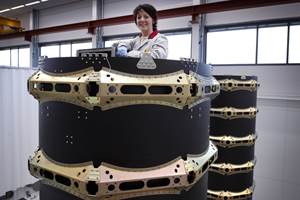Part design criteria
Designers of composite parts can choose from a wide variety of fiber reinforcements and resin systems. Knowledge of material properties is a prerequisite to satisfactory product design, but cost is a major factor, as well. Over-designed composites cannot compete with lower-cost, established material systems. The
Designers of composite parts can choose from a wide variety of fiber reinforcements and resin systems. Knowledge of material properties is a prerequisite to satisfactory product design, but cost is a major factor, as well. Over-designed composites cannot compete with lower-cost, established material systems. The well-designed part not only employs the right materials and processes to meet application requirements, but, many times, is commercially competitive with other materials, when installation, maintenance and lifecycle costs are factored into the equation.
As noted above, fiber reinforcements provide mechanical properties, such as stiffness and strength, and resin matrices provide physical characteristics, including toughness and resistance to impact, weather, fire, UV light and corrosive chemicals.
A significant design consideration is fiber-to-matrix ratio, which is a determining factor in the ultimate weight and cost of the component and governs the extent to which performance properties inherent in the fiber reinforcement can be optimized in the part. Fiber-to-resin ratio can range from 20:80 for low-cost, nonstructural components to as high as 70:30 in some high-end pultrusion applications for structural use. A 60:40 or higher ratio is common in advanced composites.
Three additional factors must be considered when designing with fiber: fiber type, form and orientation or architecture. Orientation refers to fiber direction in relation to the longest part dimension. Typically, fiber architecture is tailored in the direction of the primary loads placed on a structure, a design principle comparable to what civil engineers use to orient steel reinforcing bars in a concrete structure. Common orientations are parallel (longitudinal or 0°), circumferential (90°) and helical (usually ±33° to ±45°). However, fiber direction can vary greatly. For example, a 54° winding angle satisfies both the circumferential (hoop) and longitudinal (axial) strength requirements of most pipes and pressure vessels, usually manufactured by the filament winding process. However, if more stress is placed on the pipe in the axial direction, as is the case with an unsupported span, a ±20°/±70° fiber orientation will provide a stiffer bending modulus for increased axial strength.
Composites, by nature, allow designers to tailor fiber architecture to match the performance requirements for a specific part. Laminates may be designed to be isotropic or anisotropic, balanced or unbalanced, symmetrical or asymmetrical - depending on the in-use forces a component must withstand (see "Glossary of Terms,"p. 47). Varied fiber orientation allows a range of wall-thickness variations, making it possible to develop lightweight, complex shapes and to produce large parts with integral reinforcing members.
An understanding of layered or laminated structural behavior is vital to effective composite component design. Adhesion between laminate layers (called plies) is critical; poor adhesion can result in delamination under stress, strain, impact and load conditions. Ply layup designers must consider mechanical stresses/loads, adhesion, weight, stiffness, operating temperature and toughness requirements, as well as variables such as electromagnetic transparency and radiation resistance. Additionally, composite component design must encompass surface finish, fatigue life, overall part configuration, and scrap or rework potential, to name just a few of the many applicable factors.
The intended fabrication method also will influence design. For instance, manufacturers of filament-wound or tape-layed structures use different reinforcement forms and build-up patterns than those used either for laminate panels layed up by hand or for vacuum-bag-cured prepreg parts.Resin transfer molding (RTM) accommodates three-dimensional preforms more easily than do some other manufacturing techniques. The varying benefits and limitations of these fabrication techniques provide designers a very flexible set of options, in their efforts to achieve optimum performance and economies.
A common type of composite structure - sandwich construction - combines a lightweight core material with laminated composite skins (facesheets), similar to the construction of corrugated cardboard. These very lightweight panels have the highest stiffness-to-weight and strength-to-weight performance of all composite structures and are extremely resistant to bending and buckling. Suitable core materials include closed-cell foams, balsa wood and celled honeycomb in a variety of forms (aluminum, paper or plastic). Some foam cores are syntactic (i.e., containing hollow microspheres) for even lighter weight. Sandwich construction is used extensively on modern aircraft and boats as well as in applications such as cargo containers and modular buildings.
Related Content
Plant tour: Albany Engineered Composites, Rochester, N.H., U.S.
Efficient, high-quality, well-controlled composites manufacturing at volume is the mantra for this 3D weaving specialist.
Read MoreRUAG rebrands as Beyond Gravity, boosts CFRP satellite dispenser capacity
NEW smart factory in Linköping will double production and use sensors, data analytics for real-time quality control — CW talks with Holger Wentscher, Beyond Gravity’s head of launcher programs.
Read MoreMaterials & Processes: Fibers for composites
The structural properties of composite materials are derived primarily from the fiber reinforcement. Fiber types, their manufacture, their uses and the end-market applications in which they find most use are described.
Read MoreMaterials & Processes: Resin matrices for composites
The matrix binds the fiber reinforcement, gives the composite component its shape and determines its surface quality. A composite matrix may be a polymer, ceramic, metal or carbon. Here’s a guide to selection.
Read MoreRead Next
Composites end markets: Energy (2024)
Composites are used widely in oil/gas, wind and other renewable energy applications. Despite market challenges, growth potential and innovation for composites continue.
Read MoreFrom the CW Archives: The tale of the thermoplastic cryotank
In 2006, guest columnist Bob Hartunian related the story of his efforts two decades prior, while at McDonnell Douglas, to develop a thermoplastic composite crytank for hydrogen storage. He learned a lot of lessons.
Read MoreCW’s 2024 Top Shops survey offers new approach to benchmarking
Respondents that complete the survey by April 30, 2024, have the chance to be recognized as an honoree.
Read More






















